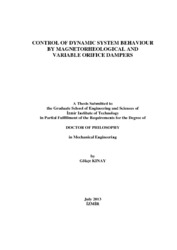Please use this identifier to cite or link to this item:
https://hdl.handle.net/11147/2963Full metadata record
| DC Field | Value | Language |
|---|---|---|
| dc.contributor.advisor | Özdemir, Serhan | - |
| dc.contributor.author | Kınay, Gökçe | - |
| dc.date.accessioned | 2014-07-22T13:48:40Z | - |
| dc.date.available | 2014-07-22T13:48:40Z | - |
| dc.date.issued | 2013-07 | - |
| dc.identifier.uri | http://hdl.handle.net/11147/2963 | - |
| dc.description | Thesis (Doctoral)--Izmir Institute of Technology, Mechanical Engineering, Izmir, 2014 | en_US |
| dc.description | Includes bibliographical references (laves: 191-203) | en_US |
| dc.description | Text in English; Abstract: Turkish and English | en_US |
| dc.description | xix, 242 leaves | en_US |
| dc.description | Full text release delayed at author's request until 2016.12.19 | en_US |
| dc.description.abstract | Passive and semi-active control devices are widely utilized for response reduction in civil engineering structures subjected to strong earthquakes. These devices absorb energy from the system. They do not add energy into the system being controlled. Therefore, the system stays stable in the sense of bounded-input-bounded-output stability. In the current study, semi-actively controlled devices were investigated: magnetorheological dampers (MRDs) and variable orifice dampers (VODs). Various control schemes were applied to control the seismic response of a three-storey model structure. Some of these control systems were composed of MRDs applied to the bare model structure. Some of them consisted of hybrid application of MRD or VOD to the seismic isolated model structure. The hybrid control, which consisted of passive and semi-active controllers, was studied in order to benefit from advantages of both strategies and to compensate for their weak properties. In the simulations, different controllers were designed depending on the linear quadratic regulator (LQR), sliding mode control, H2/LQG, fuzzy logic, and linear quadratic Gaussian (LQG). The effectiveness of the control algorithms and the usefulness of semi-active dampers for response reduction were demonstrated through various numerical examples. Kalman-Bucy filter was designed due to the necessity of an observer in real-world applications with state feedback control. Additional damping at the base level reduced the base velocity directly and decreased the base displacement indirectly at the expense of larger drifts and floor accelerations of the superstructure. The study has shown that the hybrid control system can prevent or significantly reduce structural damage during a seismic event even in case of a frequency overlap of excitation and system. Additionally, vibration response of a truck seat was controlled by three different passive dampers and the MRD. The passive dampers could effectively reduce the oscillations of the truck seat. On the other hand, the capacity of the RD-1005-3 MRD was excessive for the suspension system of the current truck seat. | en_US |
| dc.language.iso | en | en_US |
| dc.publisher | Izmir Institute of Technology | en_US |
| dc.rights | info:eu-repo/semantics/openAccess | en_US |
| dc.subject.lcsh | Damping (Mechanics) | en |
| dc.subject.lcsh | Seismic waves--Damping | en |
| dc.title | Control of Dynamics System Behaviour by Magnetorheological and Varible Orifice Dampers | en_US |
| dc.type | Doctoral Thesis | en_US |
| dc.institutionauthor | Kınay, Gökçe | - |
| dc.department | Thesis (Doctoral)--İzmir Institute of Technology, Mechanical Engineering | en_US |
| dc.relation.publicationcategory | Tez | en_US |
| dc.identifier.wosquality | N/A | - |
| dc.identifier.scopusquality | N/A | - |
| item.fulltext | With Fulltext | - |
| item.openairetype | Doctoral Thesis | - |
| item.grantfulltext | open | - |
| item.openairecristype | http://purl.org/coar/resource_type/c_18cf | - |
| item.cerifentitytype | Publications | - |
| item.languageiso639-1 | en | - |
| Appears in Collections: | Phd Degree / Doktora | |
Files in This Item:
| File | Description | Size | Format | |
|---|---|---|---|---|
| 10022436.pdf | DoctoralThesis | 27.78 MB | Adobe PDF |  View/Open |
CORE Recommender
Page view(s)
280
checked on May 12, 2025
Download(s)
256
checked on May 12, 2025
Google ScholarTM
Check
Items in GCRIS Repository are protected by copyright, with all rights reserved, unless otherwise indicated.